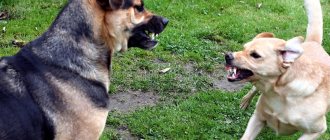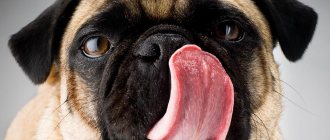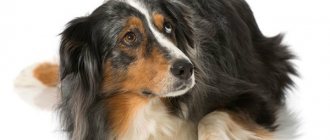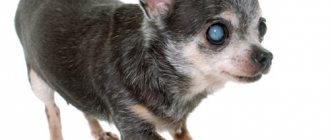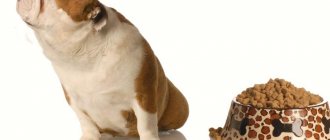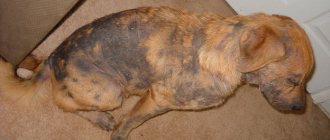The anatomy of dogs is structured differently than that of humans. When planning to have a four-legged friend, potential owners should familiarize themselves with all the intricacies of caring for him. One of the possible ailments is inflammation of the anal glands in dogs.
These glands are sacs that are located symmetrically on both sides of the anus. They secrete a special secretion that simplifies the process of defecation - they work as a lubricant. In addition, they also allow the four-legged animals to mark their territory, leaving their individual scent everywhere. In some situations, these sacs swell, causing discomfort and pain in the animal. In the final stages, this can even end in death. Let us consider in more detail the causes of the disease, as well as methods of its treatment and prevention.
Causes of inflammation
The main causes of inflammation of the anal glands are:
- Digestive disorders due to poor nutrition. It is strictly forbidden to feed puppies food from their owners. Spicy, fatty and fried foods, as well as excess protein, are taboo.
- The animal's sedentary lifestyle and short walks. Due to the infrequency of walks and their short duration, the pet often has to hold back feces. This often causes inflammation of the sacs located near the anus. A sedentary lifestyle causes obesity.
- Heredity. In this case, we are talking about the fact that small dogs are more susceptible to the disease.
- Anal injuries. Injuries or other injuries caused by diarrhea or constipation also contribute to the exacerbation of the disease.
- Frequent diarrhea. This point is largely related to the previous one, because diarrhea leads to damage to the anus.
- Weak immunity. In some cases, the cause of the disease is infection. A weakened immune system makes the dog more vulnerable.
At-risk groups
This disease most often affects four-legged dwarf and decorative breeds. French and English bulldogs, Pekingese, dachshunds and pugs, as well as other small dogs, are most susceptible to the disease. Although some researchers believe that no connections with breeds have been identified at all. Most veterinarians agree that young animals are at greatest risk.
If you can mark a match with at least one item on this list, it’s worth considering whether your friend is at risk.
Signs of itching in dogs
So, if a dog itches, then it is tormented, this is obvious. In addition to the characteristic movements of the hind paw and constant biting, an itchy animal may also frantically lick its body, whine pitifully, sleep poorly, lose interest in games, treats and favorite food (this will affect its weight), and constantly rub against the carpet or pieces of furniture. As a rule, with severe itching, the dog’s skin looks reddened, inflamed, and the condition of the coat leaves much to be desired, up to the appearance of completely hairless areas.
Dog itching
It can be either localized, for example, when a dog’s ears itch, or generalized, when the whole body itches. Sometimes you can determine the cause of scratching by simply observing your pet. For example, itching in the ears is possibly otodectosis, and if the stomach itches, it is an allergy or dermatitis. However, you should not diagnose your dog yourself; it is better to consult a specialist.
Types of the disease and the course of the disease, as well as possible complications
There are three types of the disease:
- The process of blockage of the anal glands. This is where it all begins. The secretion is not released naturally during bowel movements and accumulates. At this stage, itching and redness appear in the anus. A yellowish or transparent secretion begins to appear. The dog intensively scratches the affected area. Subsequently, the secretion becomes thicker, baldness in the anal area is observed, pustules also form on the inner side of the thigh, and pelvic paralysis occurs. Subsequently, the itching begins to cover an increasingly larger surface of the pet’s body, the secretion changes color and consistency, becoming darker and thicker.
- Inflammatory process. Suppuration occurs, and inflammation spreads from the gland itself to the surrounding tissues. If the ducts are not cleared at this stage, an abscess occurs.
- Fistula formation. Once mature, the abscess breaks out, resulting in the formation of a fistula in the area of the anal gland. During this period, the dog begins to refuse food, there is an increase in body temperature, lethargy and a depressive state. Surgical treatment is required, otherwise everything can end in death.
Algorithm of the inflammatory process in the paraanal glands
As the disease progresses, signs of an inflammatory process in the paraanal glands become more and more clearly visible.
- The normal outflow of secretory fluid is disrupted.
- A large amount of secretion accumulates in the glands.
- The consistency gradually thickens.
- “Sacs” with secretions become visible, their walls become thinner and become painful, causing discomfort to the dog.
- The altered secretion turns into an excellent environment for the growth of strains of pathogenic microorganisms.
- Due to the proliferation of secondary microflora, inflammation becomes even larger, leading to the formation of an abscess and purulent exudate.
- When an abscess ruptures, a fistula forms.
All this leads to other pathologies, so the owner of the animal must carefully monitor the condition of his pet.
Symptoms
Owners should always monitor the behavior of their furry friends. Some “alarm bells” will help the pet owner notice the disease at the initial stage, which will greatly facilitate the treatment process and prevent the dog’s suffering.
Behavioral changes
First of all, you can notice the following changes in your pet’s behavior:
- he/she begins to lick the damaged area;
- restlessness, fidgeting on the butt, which can be confused with worms;
- pain during defecation, the presence of which can be judged by the dog’s behavior;
- lethargy and refusal to eat.
Visual manifestations of the disease
Even when examined at home, you can notice violations, such as:
- redness of the anus and swelling in this area;
- baldness of the area around the anus;
- increase in body temperature.
These symptoms indicate the need to urgently contact a veterinary clinic. Although in some cases it is quite possible to clean clogged ducts yourself (the author of the video is the Children of Fauna channel).
What are paraanal glands?
On both sides of the dog's anus, just below its center, there is a pair of organs - the paraanal glands.
They are located under the skin and are not visible from the outside. However, during inflammation, upon palpation, you can feel compactions in the form of tubercles.
Ducts branch off from the glands and end at the sphincter. In terms of structure and principle of functioning, the organ is almost similar to the sebaceous and sweat glands.
How to treat a dog
The secret released during normal operation consists of hormones, and serves as a kind of animal passport. It has a specific smell, individual for each dog. That is why, when getting to know each other, four-legged friends, first of all, sniff each other’s sensitive area.
During defecation, feces mix with the fluid secreted by the glands, letting other dogs know that the territory is occupied.
The secret also serves to attract beautiful representatives of the opposite sex and scare away enemies.
Mixing of secretions with feces occurs only if the animal’s intestines and digestive system are functioning normally. If there are violations in this area, problems begin with the paraanal glands.
Many four-legged pets go their entire lives without diseases in this area, but some animals experience problems.
The sacs become overfilled with secretory fluid, and the animal is unable to clean them on its own. The dog experiences discomfort, and the risk of pathology increases.
Watch the video: Anal glands. Let's understand the problem
Diagnostics
The disease can be diagnosed by external symptoms, as well as by palpating the anal glands. To do this, you need to put on a sterile glove, place the animal in the bathtub and insert your finger into its anus. Using gentle movements, you need to feel the areas on the sides of the anus. As a rule, you can feel the enlargement of the secretion sacs by touch.
The most correct option would be to contact a veterinary clinic. A qualified specialist will make this procedure as painless as possible for your pet.
Pet treatment methods
It is important to note that you can treat your dog yourself only if it is not possible to see a doctor at the moment. To alleviate the suffering of the animal, you can use rectal suppositories with ichthyol. It is also possible to use broad-spectrum antibiotic ointments, which include amoxicillin. In addition, intramuscular injections with similar antibiotics can be given. If there are regular relapses of inflammation, veterinarians recommend cleaning the glands at home or removing them altogether.
Mechanical cleaning and antibacterial treatment
Sanitation can be carried out in two ways: external and internal.
External cleaning
You can simply and painlessly clean your dog's anal glands using an ordinary napkin and Vaseline. The animal should be placed in the bathtub and its tail raised up towards its back. This position of the tail leads to relaxation of the muscles, the ducts open, which makes cleaning as comfortable as possible. Place a napkin on the sphincter area, gently press on both sides and wipe off the released secretion with the napkin. After the procedure, the anus should be lubricated with Vaseline. Then place ichthyol suppositories for three days.
Internal cleaning
If you decide to clean your dog’s ducts in a more invasive way, then you need to put a rubber glove on your hand, and the owner’s fingers and the animal’s anus should be lubricated with Vaseline oil. The index finger is inserted into the anus, while the thumb holds the skin located near the sphincter. It is necessary to apply pressure on both sides with light massage movements. Upon completion of the procedure, we wipe the hole with chlorhexidine, and then, as with the first cleaning method, we place ichthyol suppositories rectally for three to four days. Chlorhexidine is excellent at helping to cope with inflammation, and ichthyol suppositories are most often used for hemorrhoids in people, which fully explains their use in this case.
Surgical intervention
If the glands are regularly inflamed or a fistula occurs, the problem must be solved surgically. In this case, the bags are simply removed to prevent further problems. The operation is simple and the next day the animal will feel absolutely healthy. The rehabilitation period consists of taking vitamins; in addition, it is recommended to feed the pet light food and walk it often so that it does not have to endure when it wants to empty its intestines.
Diet
As noted above, fatty, salty, fried and spicy foods should be excluded from your pet’s diet. The diet should be enriched with fiber; porridge, lean meat or balanced dry food are best. Do not forget that a mandatory addition to any dry food is always a filled bowl of water.
Loading …
Treatment of a dog if there is bleeding from the butt
Of course, the best option in this case is a trip to the veterinarian. If you do not have the opportunity to do this as soon as symptoms are detected, try to provide your pet with complete rest at first. It is advisable to apply a cold compress to the animal’s sacrum and abdomen, which will stop the bleeding and have a slight analgesic effect.
You will be interested to know whether dogs have lice and how to get rid of them.
Do not prescribe treatment yourself under any circumstances. Before being examined by a doctor, the dog does not need to be fed or given laxatives. After the diagnosis has been carried out and the dog has been diagnosed, treatment will be prescribed, including taking medications, following a diet and other measures.
Drugs
Drug therapy is most often used in the treatment of diseases. It may include taking various medications, depending on the effect you want to achieve.
The most commonly used drugs are:
- sorbents - remove toxins, stop diarrhea. These include Enterosgel, Neosmectin;
- antispasmodics - normalize intestinal motility, reduce pain (“Papaverine”, “No-shpa”);
- probiotics - necessary for restoring microflora (“Bactoneotim”, “Lactobifadol”);
- antibacterial drugs - necessary if an infection is detected (Sulgin, Tylosin);
- injections with Ringer-Locke solution - needed to restore water balance;
- hemostatic agents - prescribed for severe bleeding (Vikasol, Dicenon).
To this list it is also worth adding anthelmintic drugs, for example, Milbemax, which is used to expel parasites. There are many other specific remedies prescribed by the doctor in each individual case.
Enemas
Your veterinarian may prescribe flushes in the form of enemas to cleanse the digestive tract. This is especially true when the dog refuses to take necessary laxatives orally. The procedure has a cleansing and antitoxic effect, freeing the intestines from accumulated feces and parasites. It can be prescribed for poisoning, to prevent intoxication with decay products during the treatment of helminthiasis, as well as for diseases that provoke inflammation of the intestinal mucosa.
Find out in more detail what dogs can get sick with: infectious, parasitic and other diseases.
The solution for administering an enema is made on the basis of boiled water, cooled to a temperature of about +30°C. Various additional agents are added here, depending on what the doctor prescribed. This can be glycerin, soda, a decoction of herbs (chamomile, St. John's wort, etc.) or targeted medications.
Diet
For diseases associated with bleeding from the anus, the pet may be prescribed a diet. He will need to eat more foods high in dietary fiber. Ideally, it is better to purchase protein feeds specially designed for such cases. It is also recommended to add bran to food, which improves digestion.
Prevention
Preventive measures to avoid the development of the disease are extremely simple:
- proper, balanced and healthy nutrition for your pet;
- regular and long walks with active games and jumping;
- timely treatment of the intestines;
- Regular visits to the veterinarian to examine the anus;
- getting rid of helminths.
Obviously, it is always much easier to prevent the occurrence and development of a disease than to treat it later. Take care of your pet's health, walk it well and feed it properly, and also carefully care for your pet and may illness never befall you.
Photo gallery
Cleaning the anal glands in a veterinary clinic
Dog's anal sacs
A dog chews its tail due to inflammation of the anal glands


